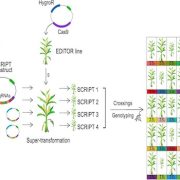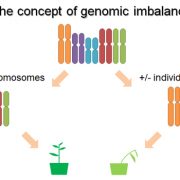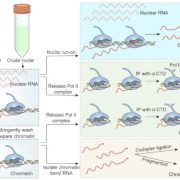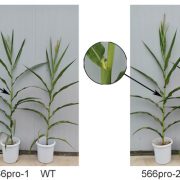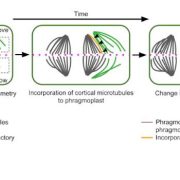Maize RNA Polymerase III Subunit NRPC2: New Kid on the Kernel Development Block
Dhineshkumar Thiruppathi 1,2
Donald Danforth Plant Science Center,
Saint Louis, Missouri 63132
1Senior author
2Author for contact: [email protected]
Seed (kernel) size affects evolutionary fitness and crop yield. In angiosperms, seed size is largely determined by the endosperm and the embryo – the products of double fertilization. Particularly in grass crop species (i.e., cereals), endosperm accounts for ~90% of kernel size and weight and is a major determinant of human nutrition (Li et al., 2017; Zhan et al., 2017). Genetic and molecular insight into endosperm development in relation to other seed-specific developmental processes has greatly been advanced by kernel size mutations in maize (Zea mays L.; Sabelli and Larkins, 2009). However, such mutations have pleiotropic effects in processes including embryo development, storage reserve filling, and seedling development. Therefore, the identified kernel-size genes are not good candidates for maize breeding programs. Identifying novel genes that control endosperm development might enrich our understanding of the regulatory mechanisms behind kernel development and could ultimately contribute to breeding crops with increased grain yield and quality. In this issue of Plant Physiology Zhao et al., (2020) describe a mechanism that links altered endosperm cell size and number to the maize kernel size, without confounding pleiotropic effects. This process includes the activity of an RNA polymerase III (RNAPIII, also known as Pol III) subunit that uncouples endosperm cell proliferation and storage reserve accumulation.
Maize endosperm, a paradigm for grasses, differentiates to constitute five recognizable cell types: the aleurone layer, central starchy endosperm cells, conducting zone, basal endosperm transfer layers, and embryo-surrounding region, with each cell type performing specific functions (Sabelli and Larkins, 2009). Concurrent with cell differentiation is an increased rate of cell division and endoreduplication of the central starchy endosperm and aleurone layer cells, which together determine endosperm cell number and size and eventually lead to the final kernel size (Sabelli and Larkins, 2009).
Mutation of the maize FLOURY3 (FL3) gene, encoding one of 17 subunits forming the RNAPIII complex that regulates gene expression involved in storage protein synthesis, results in small and floury endosperm (Li et al., 2017). Eukaryotic RNAPIII transcribes transfer RNAs (tRNAs), ribosomal 5S rRNA, and other small non-coding RNAs required for protein synthesis to control cell division and proliferation events essential for organ/tissue development (Li et al., 2017; Wang et al., 2019). In maize, the interaction of FL3 with other subunits of RNAPIII is critical for proper functionality of RNAPIII transcription events and normal endosperm development. Despite this finding, other factors and mechanisms of the RNAPIII complex potentially regulating cell differentiation and cell cycle events during endosperm development remain to be determined.
Zhao et al., (2020) screened for ethyl methane sulfonate (EMS)-induced mutations that resulted in visible small kernel (smk) phenotypes and isolated the smk7 mutant. The smk7 kernels had normal embryos but exhibited abnormalities in cell proliferation, and cell size and number in basal endosperm transfer layer, aleurone layer, conducting zone, and starchy endosperms. The authors mapped the smk7 mutation to a gene encoding the second-largest subunit of RNAPIII, NRPC2 (Nuclear RNA Polymerase C2) using map-based sequencing and confirmed that the mutation leads to a defective NRPC2 protein in smk7. The smk7 kernels showed compromised biogenesis of small noncoding RNAs such as tRNAs and 5S rRNAs, confirming that NRPC2 is a part of the RNAPIII machinery. To further verify the function of the gene, lines with reduced NRPC2 function were generated using CRIPSR-Cas9 mutagenesis, which phenocopied the mutant.
Unlike fl3, smk7 did not appear to affect the nutritional value of maize. The fl3 mutation disrupts the accumulation of starch and storage proteins (e.g., zein and non-zein proteins), leading to a soft and opaque endosperm. By contrast, storage product accumulation is normal in smk7 kernels. While endosperm quality traits are genetically uncoupled in fl3 and smk7 mutants, the small kernel traits appeared to be additive. The latter interpretation also found support from a compensatory increase in NRPC2 by fl3 mutation and physical interaction of NRPC2 with FL3.
The authors performed RNA-seq of single and double smk7 and fl3 mutants relative to WT kernels. In gene sets with altered expression in smk7 or fl3, enriched genes in were consistent with their smaller and floury kernels, respectively. In particular, the set of genes expressed at higher levels in smk7 was enriched for the terms “DNA-dependent DNA replication”, “DNA replication”, “Cell cycle process”, etc. Individual genes associated with the smk7 mutation are implicated in cell proliferation and endoreduplication: the minichromosome maintenance 2-7 gene family, the proliferating cell nuclear antigen subunit of DNA polymerase δ, and retinoblastoma-related proteins and cyclins. Upregulation of a subset of these genes positively regulates endoreduplication and cell size during maize endosperm development (Sabelli et al., 2009; Sabelli et al., 2013), a process also occurring in the smk7 endosperms. Similarly, the set of genes preferentially expressed in fl3 is enriched for “Fatty acid biosynthesis and metabolism”. Individual genes affected by the fl3 mutation include several well-characterized opaque endosperm genes such as Opaque, oxalyl-CoA decarboxylase1, and Naked endosperm1. These results suggest a major role for NRPC2 in kernel development but not in kernel quality.
This study identifies a novel gene in the control of seed size, maize NRPC2, that is functionally unique. Because NRPC2 specifically targets endosperm-specific cell differentiation events, it largely eliminates pleiotropic effects caused by other gene regulatory mutants functioning during early kernel development. Experimental and circumstantial evidence repeatedly highlight the interplay of transcriptional, hormonal and nutrient signals underlying cell fate specification and differentiation of endosperm cell types, and the communication between intra-kernel tissue types during kernel development (Sabelli and Larkins, 2009; Doll et al., 2017; Li et al., 2019). Whether ZmNRPC2 may be involved in such interplay would be worthwhile to investigate, with the potential also to decipher the functional differences between two maize RNAPIII subunits during maize kernel development. Understanding such hierarchical regulation of these networks would help build robust maize breeding programs for improved seed quality.
LITERATURE CITED:
Doll NM, Depège-Fargeix N, Rogowsky PM, Widiez T (2017) Signaling in Early Maize Kernel Development. Mol Plant. doi: 10.1016/j.molp.2017.01.008
Li Q, Wang J, Ye J, Zheng X, Xiang X, Li C, Fu M, Wang Q, Zhang Z, Wu Y (2017) The maize imprinted gene floury3 encodes a PLATZ protein required for tRNA and 5s rRNA transcription through interaction with RNA polymerase III. Plant Cell. doi: 10.1105/tpc.17.00576
Sabelli PA, Hoerster G, Lizarraga LE, Brown SW, Gordon-Kamm WJ, Larkins BA (2009) Positive regulation of minichromosome maintenance gene expression, DNA replication, and cell transformation by a plant retinoblastoma gene. Proc Natl Acad Sci U S A. doi: 10.1073/pnas.0813329106
Sabelli PA, Larkins BA (2009) The development of endosperm in grasses. Plant Physiol. doi: 10.1104/pp.108.129437
Sabelli PA, Liu Y, Dante RA, Lizarraga LE, Nguyen HN, Brown SW, Klingler JP, Yu J, LaBrant E, Layton TM, et al (2013) Control of cell proliferation, endoreduplication, cell size, and cell death by the retinoblastoma-related pathway in maize endosperm. Proc Natl Acad Sci U S A. doi: 10.1073/pnas.1304903110
Wang A, Hou Q, Si L, Huang X, Luo J, Lu D, Zhu J, Shangguan Y, Miao J, Xie Y, et al (2019) The PLATZ transcription factor GL6 affects grain length and number in rice. Plant Physiol. doi: 10.1104/pp.18.01574



